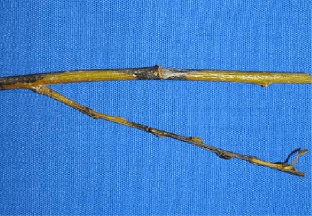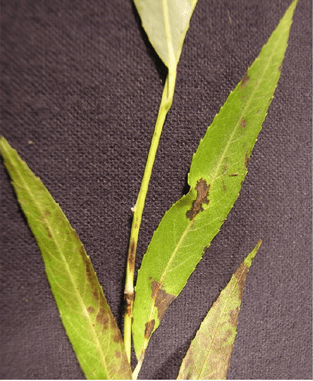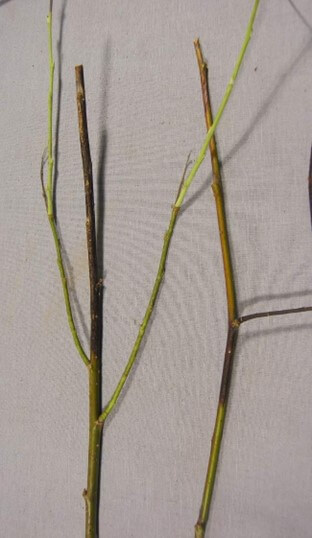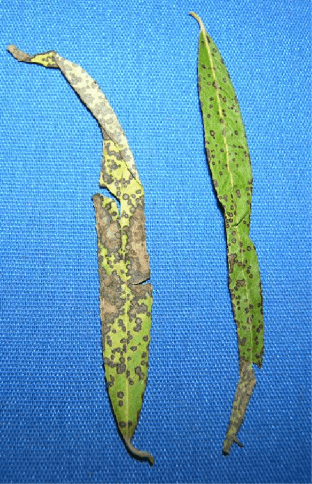Disease Notes
Contact
Plant Diagnostician
Phone: (479) 575-2727
Email: ssmith@uada.edu
Jason Pavel
Diagnostician
Phone: (479) 575-7257
Email: jpavel@uada.edu
University of Arkansas System Division of Agriculture
Cralley Warren Building
Room 16
2601 N. Young Ave.
Fayetteville, AR 72704
Willow – Common Diseases
by Sherrie Smith and Jason Pavel

Willow Black Canker – Glomerella miyabeana anamorph Colletotrichum salicis
Photo by Sherrie Smith, University of Arkansas Cooperative Extension
Willow species remain popular in the landscape despite being relatively short-lived for a tree and somewhat messy with dropped twigs and leaves. The Weeping willow is grown for its majestic size and form while the Corkscrew willow is planted for the winter interest its twisted limbs provide. Willow Blight is a catch-all term used to describe common willow diseases that often occur singly or together on a tree.
What are the symptoms of diseased willow?
Rapid branch dieback, blackened stems, and blighting of shoots and leaves are symptoms of three diseases often found together on willow. The diseases are Black Stem canker caused by Glomerella miyabeana, Willow scab caused by Venturia saliciperda, and Leaf spot caused by Pseudocercospora salicina.
Willow Scab
Willow scab attacks current year leaves in the spring, rapidly killing them. Olive green velvety spore masses develop along the veins and in spots on the underside of leaves. Small shoots are killed when the fungus grows into the petioles.
Black Canker
Black canker usually infects leaves and twigs later in the season than scab. The cankers most often appear at the nodes underlying petioles. Leaf blades that become infected turn black near the base. Leaves will shrivel and drop prematurely.
Leaf Spot
Pseudocercospora Leaf spot causes lesions 0.5 - 5 mm in diameter and irregular in shape, with brown centers and purple margins. As the disease progresses and the lesions become more numerous, the leaves turn yellow and fall from the tree. In severe cases, dieback of the branches can occur.

Willow Scab – Venturia saliciperda


salicina
Photos by Sherrie Smith, University of Arkansas Cooperative Extension
How can you avoid and control common willow diseases?
Control consists of pruning out diseased twigs, raking up fallen twigs and leaves, and avoiding overhead irrigation to prevent splashing spores to uninfected tissue. Avoiding stress by keeping willows properly watered is important in reducing the incidence and severity of these diseases. Fungicides have been used as chemical controls, but the large size of willows makes this impractical for most homeowners.
Take Aways
• Prune out diseased twigs and rake up fallen leaves
• Avoid overhead irrigation
• Avoid stress with proper care
• Where practical use fungicides such as chlorothalonil
This work is supported by the Crop Protection and Pest Management Program [grant no. 2017-70006- 27279/project accession no. 1013890] from the USDA National Institute of Food and Agriculture.